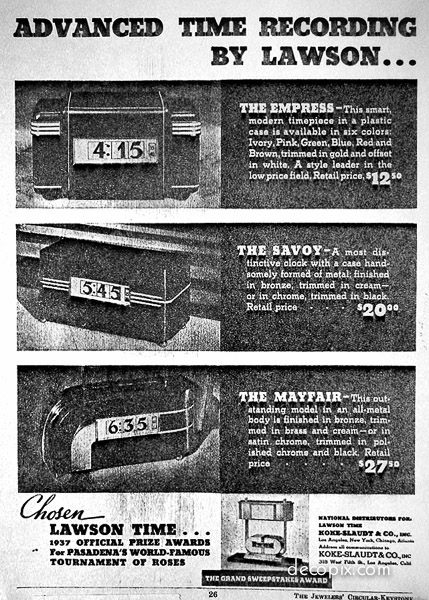With each new discovery, the Lawson Time story offers up another mystery. It now appears the Zephyr clock wasn’t called the Zephyr until 1938. It was the Mayfair, as shown in this 1937 ad from L.A. distributor Koke-Sloudt.
What prompted the name change? A guess would be Lawson’s use of the slogan “Lawson Time-Table Time” was a good fit with the record setting Burlington Zephyr train.
This advertisement provides other interesting information as well. At the top is the original Lawson plastic clock, the elusive Empress, which would be sold again in stripped down form as the Americana, late in the 1940s. At the bottom, we see the Lawson lamp/clock combination that was given as a prize at the 1937 Tournament of Roses.
Sometime between this 1937 ad and Lawson’s 1938 catalog, the Mayfair and Savoy names were dropped, replaced by the Zephyr and New Yorker. Whether there were any Mayfairs and Savoys, or if these three clocks even existed prior to 1937-38 is unknown.
Many thanks to Scott Braznell for providing this extremely rare example of early Lawson clock advertising.


I am so excited a friend gave me a batch of old clocks and one of them is a Lawson model 77. It is amazing. There isn’t much info out there on this model. Do you have any idea about this model? Thank you for sharing the info on these wonderful clocks and the history of the company.
Hi Leslie – The model 77 is a lovely, very early Lawson and rather scarce. My #77 says Lawson Clocks Limited, which dates it to 1933 or 1934 (when the company became Lawson Time, Inc.) Besides being one of the first designs, it’s also one of the few that isn’t in an Art Deco or Streamline Moderne style, presumably because Lawson had not yet settled on that yet. (In 1933, “modern” could have meant Art Deco, which was on it’s way out, or Streamline Moderne, which had just been popularized at the Chicago Worlds Fair of 1933-34.)
Another very unusual feature in the model 77 I have is that the bracket that holds the wheels is Bakelite, not metal. I discuss this a bit in the book, but it turns out that Bakelite was not the ideal material for this purpose. With a little trial and error, I was able to get my clock working just fine even though it was sold as not working. I hope this helps, and congratulations on your new clock!